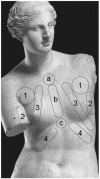Chest wall syndrome among primary care patients: a cohort study
- PMID: 17850647
- PMCID: PMC2072948
- DOI: 10.1186/1471-2296-8-51
Chest wall syndrome among primary care patients: a cohort study
Abstract
Background: The epidemiology of chest pain differs strongly between outpatient and emergency settings. In general practice, the most frequent cause is the chest wall pain. However, there is a lack of information about the characteristics of this syndrome. The aims of the study are to describe the clinical aspects of chest wall syndrome (CWS).
Methods: Prospective, observational, cohort study of patients attending 58 private practices over a five-week period from March to May 2001 with undifferentiated chest pain. During a one-year follow-up, questionnaires including detailed history and physical exam, were filled out at initial consultation, 3 and 12 months. The outcomes were: clinical characteristics associated with the CWS diagnosis and clinical evolution of the syndrome.
Results: Among 24 620 consultations, we observed 672 cases of chest pain and 300 (44.6%) patients had a diagnosis of chest wall syndrome. It affected all ages with a sex ratio of 1:1. History and sensibility to palpation were the keys for diagnosis. Pain was generally moderate, well localised, continuous or intermittent over a number of hours to days or weeks, and amplified by position or movement. The pain however, may be acute. Eighty-eight patients were affected at several painful sites, and 210 patients at a single site, most frequently in the midline or a left-sided site. Pain was a cause of anxiety and cardiac concern, especially when acute. CWS coexisted with coronary disease in 19 and neoplasm in 6. Outcome at one year was favourable even though CWS recurred in half of patients.
Conclusion: CWS is common and benign, but leads to anxiety and recurred frequently. Because the majority of chest wall pain is left-sided, the possibility of coexistence with coronary disease needs careful consideration.
Figures
References
Publication types
MeSH terms
LinkOut - more resources
Full Text Sources
Medical


